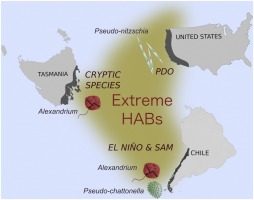Harmful Algae ( IF 5.5 ) Pub Date : 2019-05-03 , DOI: 10.1016/j.hal.2019.03.009 Vera L Trainer 1 , Stephanie K Moore 1 , Gustaaf Hallegraeff 2 , Raphael M Kudela 3 , Alejandro Clement 4 , Jorge I Mardones 5 , William P Cochlan 6

|
Time series now have sufficient duration to determine harmful algal bloom (HAB) responses to changing climate conditions, including warming, stratification intensity, freshwater inputs and natural patterns of climate variability, such as the El Niño Southern Oscillation and Pacific Decadal Oscillation. Against the context of time series, such as those available from phytoplankton monitoring, dinoflagellate cyst records, the Continuous Plankton Recorder surveys, and shellfish toxin records, it is possible to identify extreme events that are significant departures from long-term means. Extreme weather events can mimic future climate conditions and provide a “dress rehearsal” for understanding future frequency, intensity and geographic extent of HABs. Three case studies of extreme HAB events are described in detail to explore the drivers and impacts of these oceanic outliers that may become more common in the future. One example is the chain-forming diatom of the genus Pseudo-nitzschia in the U.S. Pacific Northwest and its response to the 2014-16 northeast Pacific marine heat wave. The other two case studies are pelagic flagellates. Highly potent Alexandrium catenella group 1 dinoflagellate blooms (up to 150 mg/kg PST in mussels; 4 human poisonings) during 2012-17 created havoc for the seafood industry in Tasmania, south-eastern Australia, in a poorly monitored area where such problems were previously unknown. Early evidence suggests that changes in water column stratification during the cold winter-spring season are driving new blooms caused by a previously cryptic species. An expansion of Pseudochattonella cf. verruculosa to the south and A. catenella to the north over the past several years resulted in the convergence of both species to cause the most catastrophic event in the history of the Chilean aquaculture in the austral summer of 2016. Together, these two massive blooms were colloquially known as the “Godzilla-Red tide event”, resulting in the largest fish farm mortality ever recorded worldwide, equivalent to an export loss of USD$800 million which when combined with shellfish toxicity, resulted in major social unrest and rioting. Both blooms were linked to the strong El Niño event and the positive phase of the Southern Annular Mode, the latter an indicator of anthropogenic climate change in the southeastern Pacific region. For each of these three examples, representing recent catastrophic events in geographically distinct regions, additional targeted monitoring was employed to improve the understanding of the climate drivers and mechanisms that gave rise to the event and to document the societal response. Scientists must be poised to study future extreme HAB events as these natural experiments provide unique opportunities to define and test multifactorial drivers of blooms.
中文翻译:

中上层有害藻华和气候变化:自然界极端实验的经验教训。
现在,时间序列具有足够的持续时间来确定有害藻华(HAB)对不断变化的气候条件的响应,包括变暖,分层强度,淡水输入和气候变化的自然模式,例如厄尔尼诺南方涛动和太平洋年代际涛动。在时间序列的背景下,例如浮游植物监测,鞭毛藻囊肿记录,连续浮游生物记录仪调查和贝类毒素记录中的时间序列,有可能识别出与长期手段有重大偏离的极端事件。极端天气事件可以模仿未来的气候条件,并为了解HAB的未来频率,强度和地理范围提供“装扮彩排”。详细描述了三个极端HAB事件的案例研究,以探讨这些可能在未来变得更加普遍的海洋异常值的驱动因素和影响。一个例子是该属的成链硅藻美国西北太平洋地区的假性尼兹卡虫及其对2014-16年东北太平洋海洋热浪的响应。其他两个案例研究是中上鞭毛虫。在2012-17年期间,强力的亚历山大海藻第1组鞭毛藻(贻贝中PST高达150 mg / kg; 4人中毒)对澳大利亚东南部塔斯马尼亚州的一个海鲜食品业造成了严重破坏,而该地区受到严重监控以前未知。早期证据表明,在寒冷的冬春季节期间,水柱分层的变化正在推动由先前隐性物种引起的新水华。假单胞菌的扩展cf. 南部的verruculosa和A. catenella在过去的几年中,北半球导致这两个物种的融合,从而在2016年的夏季发生了智利水产养殖历史上最严重的事件。这两种大花加在一起被俗称为“哥斯拉红”(Godzilla-Red)。潮事件”,造成全世界有史以来最大的养鱼场死亡率,相当于出口损失8亿美元,再加上贝类毒性,导致重大的社会动荡和骚乱。两次开花均与强烈的厄尔尼诺事件和南部环状模式的积极阶段有关,后者是东南太平洋地区人为气候变化的指示。对于这三个示例中的每一个,都代表了地理上不同区域的近期灾难性事件,此外,还进行了有针对性的监测,以增进对引起事件的气候驱动因素和机制的了解,并记录社会反应。科学家必须准备好研究未来的极端HAB事件,因为这些自然实验为定义和测试水华的多因素驱动因素提供了独特的机会。









































 京公网安备 11010802027423号
京公网安备 11010802027423号